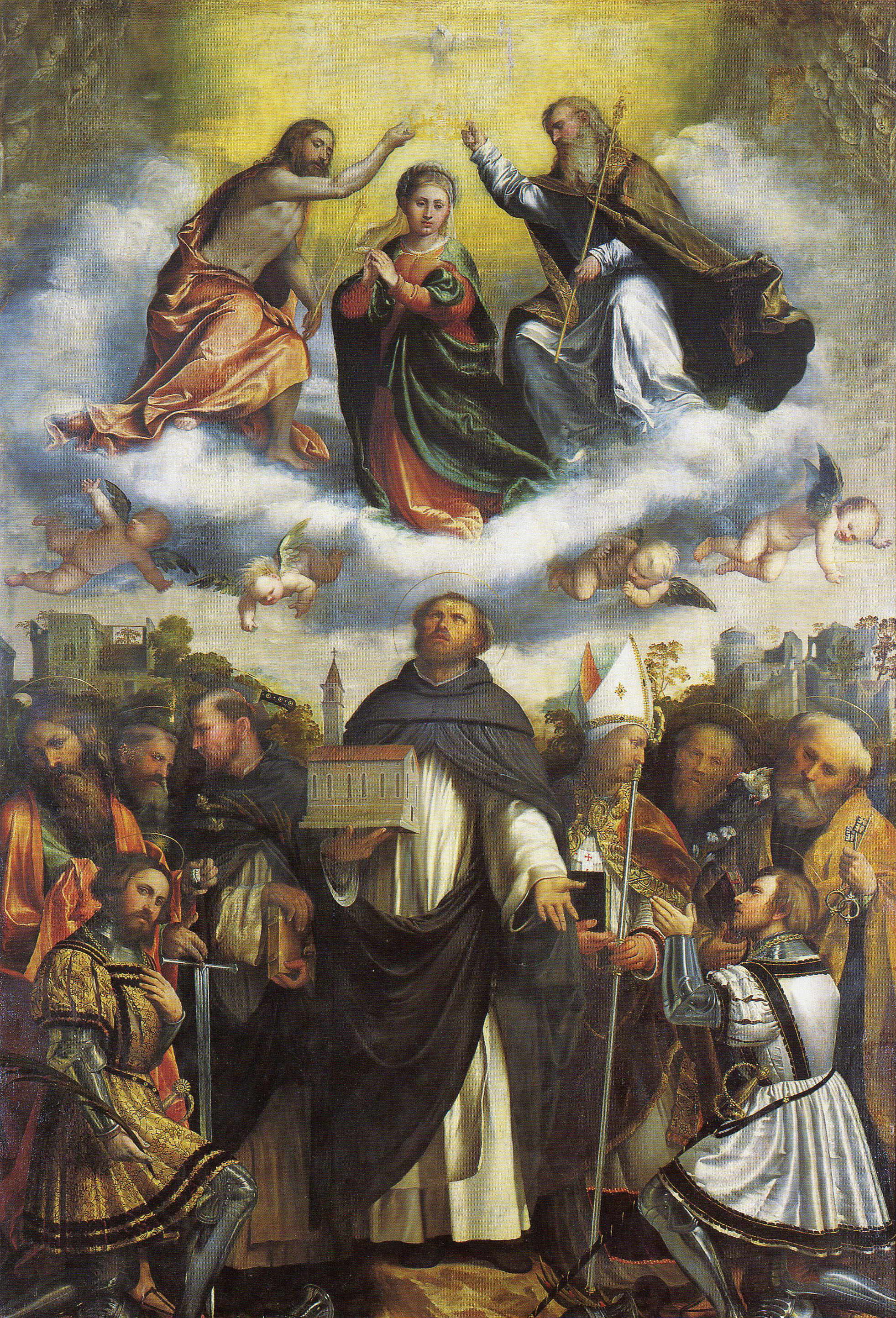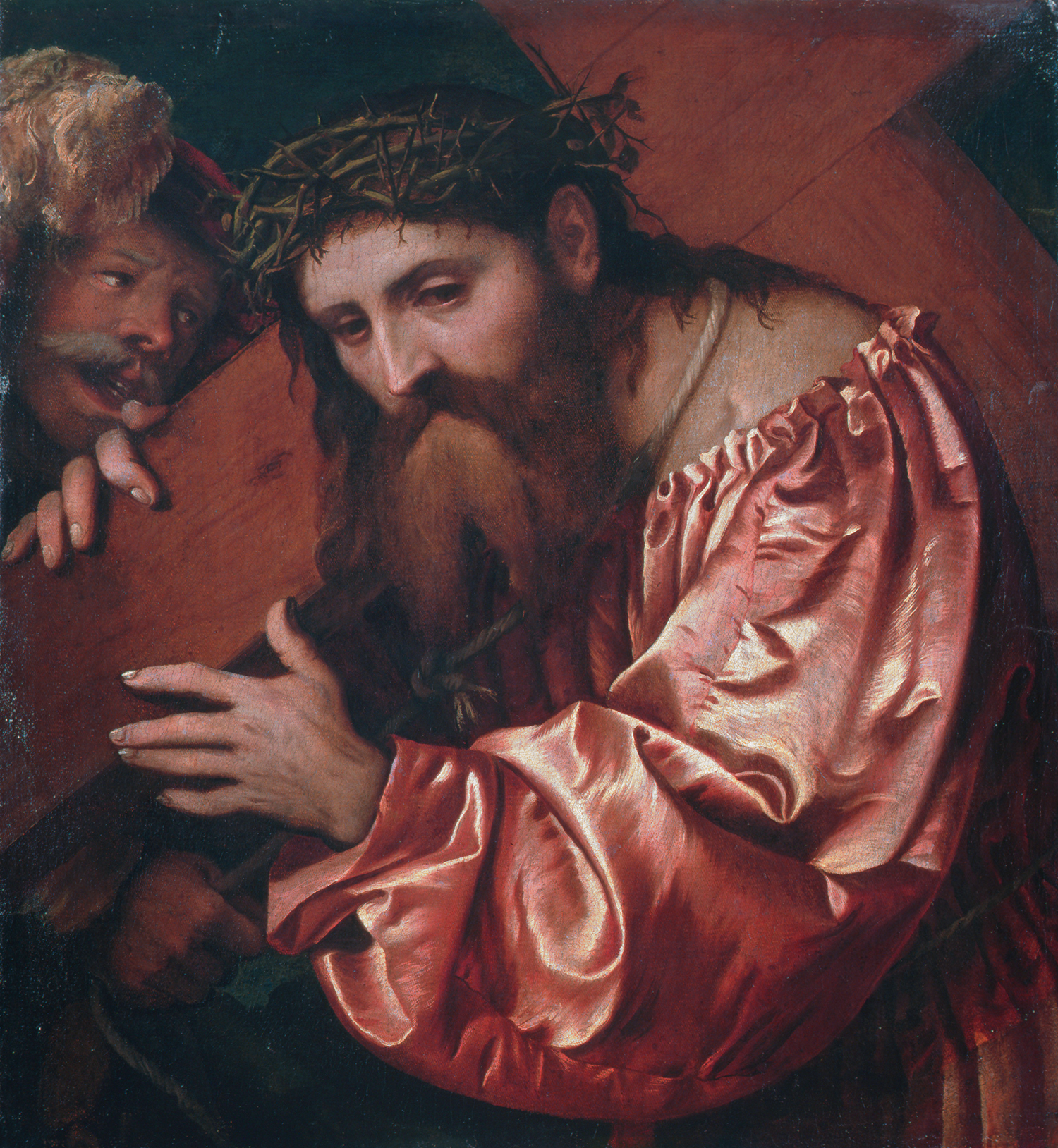Girolamo Romanino on:
[Wikipedia]
[Google]
[Amazon]
Girolamo Romani, known as Romanino (c. 1485 - c. 1566), was an
 Romani was born in Brescia. His early training and life are not well documented.
A Quattrocento-esque ''Pietà'', painted for the church of ''San Lorenzo'' of Brescia, dated from 1510, is exhibited in the Accademia. He took up residence in Venice in his twenties, at the latest by 1513. He was commissioned to complete a ''Madonna enthroned with four saints'' for the church of Santa Giustina in Padua in 1513. The coloration of the painting is of Venetian style, but the duller visages in bejeweled setting recalls styles of previous generations. He completed series of frescoes for Niccolò Orsini's Palace in Ghedi and an altarpiece for
Romani was born in Brescia. His early training and life are not well documented.
A Quattrocento-esque ''Pietà'', painted for the church of ''San Lorenzo'' of Brescia, dated from 1510, is exhibited in the Accademia. He took up residence in Venice in his twenties, at the latest by 1513. He was commissioned to complete a ''Madonna enthroned with four saints'' for the church of Santa Giustina in Padua in 1513. The coloration of the painting is of Venetian style, but the duller visages in bejeweled setting recalls styles of previous generations. He completed series of frescoes for Niccolò Orsini's Palace in Ghedi and an altarpiece for  His ''St. Matthew and the Angel'' depicts the apostle at work under candlelight, and represents one of the first such nocturnes in Italian painting, a device which Correggio and
His ''St. Matthew and the Angel'' depicts the apostle at work under candlelight, and represents one of the first such nocturnes in Italian painting, a device which Correggio and
"474-year-old painting stolen by Nazis given to owner's heirs"
from MSNBC
Painters of reality: the legacy of Leonardo and Caravaggio in Lombardy
an exhibition catalog from The Metropolitan Museum of Art (fully available online as PDF), which contains material on Romani (see index) {{DEFAULTSORT:Romani, Girolamo 1480s births 1560s deaths 15th-century Italian painters Italian male painters 16th-century Italian painters Italian Renaissance painters Painters from Brescia
Italian High Renaissance
In art history, the High Renaissance was a short period of the most exceptional artistic production in the Italian states, particularly Rome, capital of the Papal States, and in Florence, during the Italian Renaissance. Most art historians stat ...
painter active in the Veneto and Lombardy
Lombardy ( it, Lombardia, Lombard language, Lombard: ''Lombardia'' or ''Lumbardia' '') is an administrative regions of Italy, region of Italy that covers ; it is located in the northern-central part of the country and has a population of about 10 ...
, near Brescia. His long career brought forth several different styles.
Biography
 Romani was born in Brescia. His early training and life are not well documented.
A Quattrocento-esque ''Pietà'', painted for the church of ''San Lorenzo'' of Brescia, dated from 1510, is exhibited in the Accademia. He took up residence in Venice in his twenties, at the latest by 1513. He was commissioned to complete a ''Madonna enthroned with four saints'' for the church of Santa Giustina in Padua in 1513. The coloration of the painting is of Venetian style, but the duller visages in bejeweled setting recalls styles of previous generations. He completed series of frescoes for Niccolò Orsini's Palace in Ghedi and an altarpiece for
Romani was born in Brescia. His early training and life are not well documented.
A Quattrocento-esque ''Pietà'', painted for the church of ''San Lorenzo'' of Brescia, dated from 1510, is exhibited in the Accademia. He took up residence in Venice in his twenties, at the latest by 1513. He was commissioned to complete a ''Madonna enthroned with four saints'' for the church of Santa Giustina in Padua in 1513. The coloration of the painting is of Venetian style, but the duller visages in bejeweled setting recalls styles of previous generations. He completed series of frescoes for Niccolò Orsini's Palace in Ghedi and an altarpiece for San Francesco, Brescia
San Francesco is a Romanesque-Gothic style, Roman Catholic church and Franciscan monastery located on Via San Francesco d'Assisi in central Brescia, region of Lombardy, Italy.
History
The Franciscan order arrived in Brescia around 1220, after ...
.
Romanino completed four frescoes in the nave of the cathedral of Cremona in 1519-1520 depicting stories of the ''Passion of Christ''. His paintings have eclectic influences using Venetian coloration with Florentine-Lombard modeling. In the Cremona frescoes, the Lombard influence of Altobello Melone is strong, in the narrative and decorative elements of the fresco. By 1521, Romanino was replaced by Il Pordenone in the decoration of the church.
He then returned to Brescia to work (1521–1524) with Alessandro Bonvicino in the decoration of the "Cappella del Sacramento" in ''San Giovanni Evangelista''.
 His ''St. Matthew and the Angel'' depicts the apostle at work under candlelight, and represents one of the first such nocturnes in Italian painting, a device which Correggio and
His ''St. Matthew and the Angel'' depicts the apostle at work under candlelight, and represents one of the first such nocturnes in Italian painting, a device which Correggio and Cambiaso Cambiaso is an Italian surname. Notable people with the surname include:
* Adolfo Cambiaso (born 1975), Argentine polo player
* Andrea Cambiaso (born 2000), Italian football player
* Luigi Cambiaso (1895–1975), Italian gymnast
* Luca Cambiaso ( ...
would soon pursue. He also helped decorate the Palazzo Averoldi
A palace is a grand residence, especially a royal residence, or the home of a head of state or some other high-ranking dignitary, such as a bishop or archbishop. The word is derived from the Latin name palātium, for Palatine Hill in Rome which ...
. A series of frescoes in the Castle of Malpaga, near Bergamo
Bergamo (; lmo, Bèrghem ; from the proto- Germanic elements *''berg +*heim'', the "mountain home") is a city in the alpine Lombardy region of northern Italy, approximately northeast of Milan, and about from Switzerland, the alpine lakes Como ...
(1520-1530s), celebrating the life of Bartolomeo Colleoni, is attributed to him.
In 1531 to 1532, he worked with Dosso Dossi in fresco decoration of Castello del Buoncosiglio in Trento. He completed organ shutters for the church of Asola on ''Augustus and the sibyl'', and ''Sacrifice of Isaac''. Around 1545 he produced ''The Feast in the House of Simon the Pharisee '' The Feast in the House of Simon the Pharisee'' may refer to:
* ''The Feast in the House of Simon the Pharisee'' (Romanino), a c. 1545 oil on canvas painting, in Brescia
* ''The Feast in the House of Simon the Pharisee'' (Rubens), a c. 1618–1620 ...
'', still in Brescia. He died between 1559 and 1561. His main pupils were his son-in-law Lattanzio Gambara
Lattanzio Gambara (c. 1530 – 18 March 1574) was an Italian painter, active in Renaissance and Mannerist styles. It is likely that Gambara is the same 16th century painter referred to as ''Lattanzio Cremonese'' or ''Lattanzio da Cremona''.
Biog ...
, Girolamo Muziano, and Stefano Rosa
Stefano is the Italian form of the masculine given name Στέφανος (Stefanos, Stephen). The name is of Greek origin, Στέφανος, meaning a person who made a significant achievement and has been crowned. In Orthodox Christianity the ach ...
. He is also known to have influenced artists such as Giulio Campi.
Stolen painting
Shortly after the 1940 Nazi invasion of France, Romanino's painting ''Christ Carrying the Cross'' was stolen from the household of Frederico Gentili di Giuseppe, an Italian Jew. In 2012, it was discovered among items lent to an American museum from an Italian museum. Through the help of an anonymous tip, Interpol and the United States Department of Homeland Security, it was eventually returned to Gentili's heirs. Presently it is insured for US$2.5 million.from MSNBC
References
Sources
*External links
Painters of reality: the legacy of Leonardo and Caravaggio in Lombardy
an exhibition catalog from The Metropolitan Museum of Art (fully available online as PDF), which contains material on Romani (see index) {{DEFAULTSORT:Romani, Girolamo 1480s births 1560s deaths 15th-century Italian painters Italian male painters 16th-century Italian painters Italian Renaissance painters Painters from Brescia